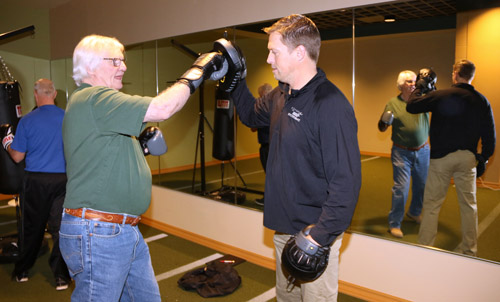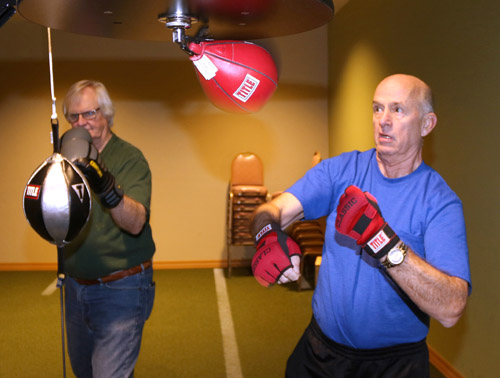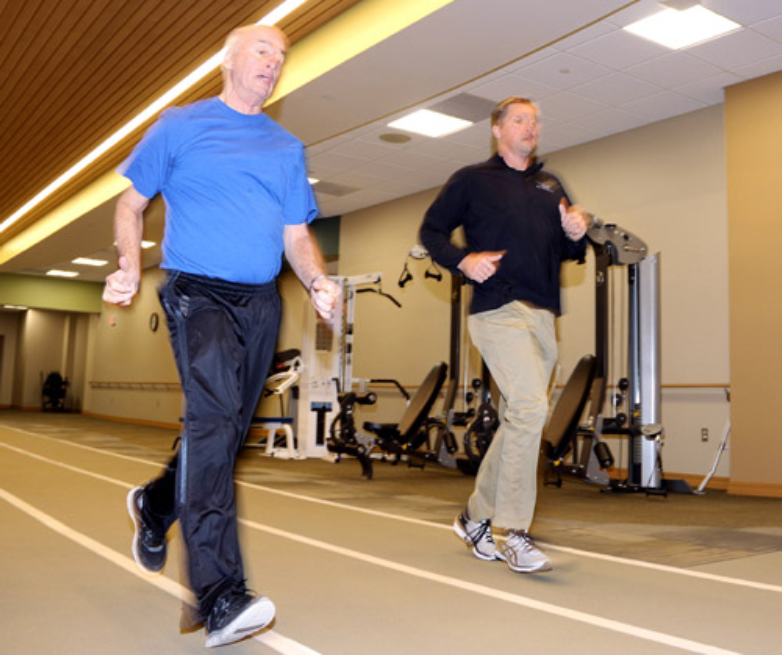posted
on 6/7/2019
in
Features
 Sharp popping sounds ring through the St. Anthony Regional Hospital physical-therapy room as Don Granstra smacks the punching-mitt targets.
Sharp popping sounds ring through the St. Anthony Regional Hospital physical-therapy room as Don Granstra smacks the punching-mitt targets.
Nearby, Dennis Molitor’s jabs keep a speed bag flying — rat-tat-tat-tat.
Strapping on boxing gloves and working out at the same time, Granstra and Molitor are training at throwing punches a common opponent.
They’ve been boxing teammates, stepping into the ring against an opponent that to this point has been formidable. Yet, Granstra and Molitor have gamely counterpunched, even sending this foe into retreat for awhile.
Granstra and Molitor both are fighting Parkinson’s disease, a neurological disorder that  causes tremors, throws off their balance and coordination, and causes other symptoms.
causes tremors, throws off their balance and coordination, and causes other symptoms.
Both have participated in St. Anthony’s weekly Delay the Disease Parkinson’s support group, where light exercise is part of the sessions.
But they decided they wanted to step up their workout intensity after Granstra attended an Iowa Parkinson’s Association meeting in Des Moines where he learned about the Rock Steady Boxing program. Rock Steady Boxing was founded in 2006 by former Marion County, Indiana, Prosecutor Scott C. Newman, who was diagnosed with early-onset Parkinson’s at age 40. According to Rock Steady Boxing informational material, Newman began intense one-on-one boxing training a few years later and experienced dramatic improvement in his physical health, agility and daily functioning.
There were six participants in the first Rock Steady Boxing class, held Oct. 14, 2006, in a small borrowed gym in Indianapolis.
Today Rock Steady Boxing is offered in 44 states and 12 other countries.
After seeing the demonstration in Des Moines, Granstra suggested St. Anthony offer the program here.
St. Anthony Physical Therapy Department Director Jeff Aden approached Steve Schable, director of St. Anthony’s Sports Performance program, about going to Indianapolis to become a certified Rock Steady Boxing instructor.
Schable gained his certification last fall, and has gained an appreciation for the physical benefits boxing training provides.
“(Boxing) is quite a sport,” said Schable, who’s been an athletic trainer with St. Anthony nearly 17 years, helping school athletes improve their speed, agility, flexibility, jumping ability, etc. “I’ve gained a lot of respect for it in the short time I’ve dealt with it. It’s a total-body activity. You’re working on hand-eye coordination, you’re working on balance, you’re working core strength, footwork. It’s total body, and with Parkinson’s, it’s important to engage as much of the body as you can.”
Since Schable became certified and began leading Rock Steady Boxing classes last October, Granstra and Molitor have been the only participants so far.
But Granstra, Molitor and Schable all have declared it a unanimous decision: Rock Steady Boxing is a winner.
“Almost within a week or two I was walking better without tripping and banging into stuff because I had been off-balance,” Granstra said. “So my balance has improved greatly, and I expect it to improve even more.”
Molitor said, “The benefits are I’ve gotten stronger, more endurance, better balance, and I’ve been able to work on some specific deficiencies. That’s the thing about Parkinson’s. Everybody seems to be unique. There’s no one-size-fits-all.”
Schable observed, “For both Dennis and Don, their confidence has gotten so much better. They came in here and they were a little unsure. ‘Oh boy, I’m getting up there in age (Granstra is 73, and Molitor 64). I’m not sure whether I should be getting up a pretty good sweat like I am.’ And after about two weeks, they were both like, ‘All right, what’s next?’ They’re looking forward to what I have in store for them.
“It’s kind of a love-hate relationship in a way. They may hate what I come up with, but they love it when they’ve finished.”
Granstra said, “Whenever I come out of there after working out for an hour and a half, I’m so exhausted and it’s a good workout. I get home, take a hot shower and lay down for awhile, maybe sleep for a half-hour or so, and then I’m up and I’m ready to go for the day.”
The 1¼- to 1½-hour classes have met Monday and Wednesday mornings and Friday afternoons. However, Schable will accommodate all participants’ schedules and individualize the workouts to their abilities and needs.
For Granstra and Molitor, both categorized as Level 1 or least severe, workouts have included stretching, coordination and strength aspects, and of course boxing, throwing punches at different types of bags or mitts that Schable wears. The classes finish with static stretching and cool-down. The exercises may vary from session to session to keep them from becoming monotonous.
Schable said, “There’s also adapting during the session, sometimes depending on how they (participants) are feeling, how their coordination is that day. We can feed off that and either make it more intense or back off a little bit. Ultimately we want each session to be successful for them where they can walk out of here feeling positive that they got something accomplished.”
 Adapting workouts to each patient, Schable said, “No two people are ever the same with the diagnosis.”
Adapting workouts to each patient, Schable said, “No two people are ever the same with the diagnosis.”
So Schable begins patients with individual baseline tests to determine focus areas where improvements can be made.
With Granstra and Molitor both categorized at Level 1, Schable said, “They are able to walk in by themselves. They don’t need assistance with anything. They’re able to balance well, communicate, function normally. But we’re set up where we can work with all levels.”
For Granstra, who retired from a career in banking and investment, he was diagnosed six years ago.
“One morning I woke up and didn’t feel just right and was kind of shaky and quivering all over,” he recalled.
Granstra said he’s since learned that his Parkinson’s was likely caused by heavy exposure to the chemical Agent Orange during Army combat in the Vietnam War.
For Molitor, who retired in 2009 after 31 years as an Iowa State University Extension director including three years in Rockwell City and the final 28 years in Carroll, the first sign appeared about 15 years ago when his family was readying for his parents’ 50th wedding anniversary celebration. A former standout football and track athlete in high school at Ruthven, in north-central Iowa, his body subtly began betraying him.
“We were just getting ready to leave for the celebration,” he recalled, “and I noticed my dad’s tie wasn’t quite right. I went to fix it, and I couldn’t. I couldn’t make my hand go up and turn that tie.”
For him, Molitor said, progression of the disease has been slower than it might be for someone diagnosed at an older age.
Granstra in August 2016 underwent deep brain penetration stimulation surgery at the University of Iowa Hospitals to relieve his hand tremors.
“That has really helped my shakes,” he said. “After that operation, the shaking is virtually gone. So now I’m concentrating on getting good balance.”
Schable said, “Right now there’s no cure for Parkinson’s disease, but research is showing that high-intensity exercise is really kind of putting on the brakes and slowing down the effects of it quite a bit, so as long as we can kind of keep inching forward, and not going backwards, we’re making progress.”
Schable said St. Anthony’s equipment expense for Rock Steady Boxing was nominal, purchasing gloves and the different punching bags: heavy bag, speed bag and double-end bag. The program also uses equipment that was already in the physical-therapy department for agility, balance and strength exercises.
Schable said there are a lot of similarities between the Sports Performance program for young athletes and the Rock Steady Boxing.
“It involves coordination, it involves core strength, it involves flexibility,” he said.
With Granstra and Molitor being the first two Rock Steady Boxing participants, Schable said, “They’re kind of my guinea pigs, because other than that course in Indianapolis, I’d had minimal experience with Parkinson’s. But relating the athletic demographic, which I’ve always had, to these guys, just because they’re older doesn’t mean they can’t do it. They have some limitations, but I have them doing very similar activities to what my Sports Performance is all about.”
Schable said Rock Steady Boxing can benefit many more Parkinson’s patients.
Granstra recently left the class recently when he and his wife, Patricia, who retired as an English department teacher at Des Moines Area Community College in Carroll, moved to Russellville, Arkansas, for its mild winters and proximity to Civil War historic sites. The Granstras both have a keen interest in Civil War history.
In Russellville, a city of about 28,000 in north-central Arkansas, Granstra said, he’s joined a workout center but also will be encouraging the hospital to begin offering Rock Steady Boxing.
Schable said of the St. Anthony class, “We’d like to have more people aware of this and utilize the program because we know there’s a fair number of people in the Carroll area who have Parkinson’s that could benefit from this.”
Anybody interested can contact Schable at 794-5241 to visit about the program.
Both Granstra and Molitor give Schable high marks as a Rock Steady Boxing instructor.
“Oh man, what a guy,” Granstra said. “He’s just one of those kind of guys. You want to do well just because you want to make him happy. For whatever reason he’s just that kind of guy, he brings it out of you. And he’s enthusiastic. When you do something right he’s very enthusiastic about you. He likes to see the improvements we’re making.”
Molitor said he’s grateful for the patience, perseverance and understanding of all Parkinson’s caregivers.
“The fact is the symptoms can change dramatically throughout the day,” he noted, “and to take the time to be educated about the disease and provide the care they give is very commendable. ... So we applaud their involvement, their patience and their commitment to delaying and defeating the disease.”
By LARRY DEVINE, News Editor, Carroll Times Herald
Originally published on February 15, 2018 Reprinted here by permission
To learn more, visit our Rock Steady webpage here.
Filter
- parkinson's disease
- rehab
- rehabilitation services
- rock steady